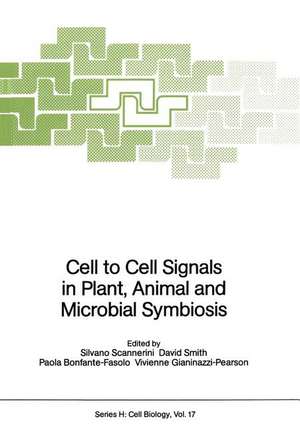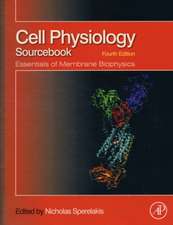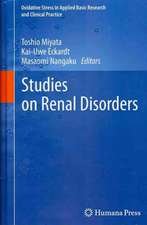Cell to Cell Signals in Plant, Animal and Microbial Symbiosis: Nato ASI Subseries H:, cartea 17
Editat de Silvano Scannerini, David Smith, Paola Bonfante-Fasolo, Vivienne Gianinazzi-Pearsonen Limba Engleză Paperback – 27 dec 2011
Din seria Nato ASI Subseries H:
- 18%
 Preț: 953.82 lei
Preț: 953.82 lei -
 Preț: 393.13 lei
Preț: 393.13 lei - 15%
 Preț: 643.34 lei
Preț: 643.34 lei - 15%
 Preț: 643.34 lei
Preț: 643.34 lei - 15%
 Preț: 641.03 lei
Preț: 641.03 lei - 15%
 Preț: 642.83 lei
Preț: 642.83 lei - 15%
 Preț: 642.51 lei
Preț: 642.51 lei - 5%
 Preț: 712.81 lei
Preț: 712.81 lei -
 Preț: 392.97 lei
Preț: 392.97 lei - 15%
 Preț: 651.02 lei
Preț: 651.02 lei - 15%
 Preț: 640.24 lei
Preț: 640.24 lei - 18%
 Preț: 948.61 lei
Preț: 948.61 lei - 15%
 Preț: 655.92 lei
Preț: 655.92 lei - 15%
 Preț: 655.92 lei
Preț: 655.92 lei - 15%
 Preț: 653.14 lei
Preț: 653.14 lei - 15%
 Preț: 655.13 lei
Preț: 655.13 lei - 15%
 Preț: 652.17 lei
Preț: 652.17 lei - 15%
 Preț: 675.58 lei
Preț: 675.58 lei - 18%
 Preț: 958.07 lei
Preț: 958.07 lei - 18%
 Preț: 961.41 lei
Preț: 961.41 lei - 18%
 Preț: 970.56 lei
Preț: 970.56 lei - 5%
 Preț: 1100.30 lei
Preț: 1100.30 lei - 5%
 Preț: 376.43 lei
Preț: 376.43 lei - 15%
 Preț: 650.86 lei
Preț: 650.86 lei - 15%
 Preț: 644.63 lei
Preț: 644.63 lei - 15%
 Preț: 655.60 lei
Preț: 655.60 lei - 18%
 Preț: 963.47 lei
Preț: 963.47 lei - 15%
 Preț: 648.42 lei
Preț: 648.42 lei - 5%
 Preț: 731.43 lei
Preț: 731.43 lei - 15%
 Preț: 653.14 lei
Preț: 653.14 lei - 18%
 Preț: 960.13 lei
Preț: 960.13 lei - 18%
 Preț: 968.34 lei
Preț: 968.34 lei - 18%
 Preț: 953.97 lei
Preț: 953.97 lei - 15%
 Preț: 654.95 lei
Preț: 654.95 lei - 15%
 Preț: 652.49 lei
Preț: 652.49 lei - 15%
 Preț: 650.86 lei
Preț: 650.86 lei - 5%
 Preț: 367.64 lei
Preț: 367.64 lei - 5%
 Preț: 1104.68 lei
Preț: 1104.68 lei - 18%
 Preț: 953.20 lei
Preț: 953.20 lei - 15%
 Preț: 651.99 lei
Preț: 651.99 lei - 15%
 Preț: 647.27 lei
Preț: 647.27 lei - 15%
 Preț: 653.00 lei
Preț: 653.00 lei - 15%
 Preț: 656.25 lei
Preț: 656.25 lei - 18%
 Preț: 962.35 lei
Preț: 962.35 lei - 15%
 Preț: 644.82 lei
Preț: 644.82 lei - 15%
 Preț: 666.55 lei
Preț: 666.55 lei - 15%
 Preț: 642.68 lei
Preț: 642.68 lei - 15%
 Preț: 645.96 lei
Preț: 645.96 lei - 15%
 Preț: 651.84 lei
Preț: 651.84 lei
Preț: 650.19 lei
Preț vechi: 764.93 lei
-15% Nou
Puncte Express: 975
Preț estimativ în valută:
124.45€ • 135.23$ • 104.61£
124.45€ • 135.23$ • 104.61£
Carte tipărită la comandă
Livrare economică 21 aprilie-05 mai
Preluare comenzi: 021 569.72.76
Specificații
ISBN-13: 9783642731563
ISBN-10: 3642731562
Pagini: 436
Ilustrații: XX, 414 p.
Dimensiuni: 170 x 244 x 23 mm
Greutate: 0.69 kg
Ediția:Softcover reprint of the original 1st ed. 1988
Editura: Springer Berlin, Heidelberg
Colecția Springer
Seria Nato ASI Subseries H:
Locul publicării:Berlin, Heidelberg, Germany
ISBN-10: 3642731562
Pagini: 436
Ilustrații: XX, 414 p.
Dimensiuni: 170 x 244 x 23 mm
Greutate: 0.69 kg
Ediția:Softcover reprint of the original 1st ed. 1988
Editura: Springer Berlin, Heidelberg
Colecția Springer
Seria Nato ASI Subseries H:
Locul publicării:Berlin, Heidelberg, Germany
Public țintă
ResearchCuprins
I. Physiology and Morphology of Cell-to-Cell Interactions.- Cellular interactions between host and endosymbiont in dinitrogen-fixing root nodules of woody plants.- Recognition mechanisms in the Azolla-Anabaena symbiosis.- The functional morphology of cell-to-cell interactions in lichens.- Host-fungus interactions in ectomycorrhizae.- Morphological integration and functional compatibility between symbionts in vesicular arbuscular endomycorrhizal associations.- Cell to cell interactions in insect endocytobiosis.- Luminescent bacteria: symbionts of nematodes and pathogens of insects.- Cell-to-cell interactions during the establishment of the Hydra-Chlorella symbiosis.- Specificity in the Convoluta roscoffensis/Tetraselmis symbiosis.- The cell structures of plant, animal and microbial symbionts, their differences and similarities.- Symbiosis and evolution: a brief guide to recent literature.- II. Signals in Plants.- Molecular signals in plant cell recognition.- Early recognition signals in the Rhizobium trifolii-white clover symbiosis.- Flavonoid compounds as molecular signals in Rhizobium-legume symbiosis.- Soredia formation of compatible and incompatible lichen symbionts.- The role of the cell wall as a signal in mycorrhizal associations.- III. Signals in Animals.- Peptide and carbohydrate moieties as molecular signals in animal cell recognition.- Genetical and biochemical interactions between the host and its endocytobiotes in the weevils Sitophilus (Coleoptere, Curculionidae) and other related species.- Signals in the Paramecium Bursaria — Chlorella Sp. association.- Nutritional interactions as signals in the green hydra symbiosis.- The establishment of algal/hydra symbioses — A case of recognition or preadaptation?.- Factors produced by symbiotic marineinvertebrates which affect translocation between the symbionts.- Specificity in dinomastigote-marine invertebrate symbioses: an evaluation of hypotheses of mechanisms involved in producing specificity.- IV. Recommendations for Future Research and Applications.- Applications of genetic engineering to “Symbiontology” in agriculture.- The application of monoclonal antibody technology to the study of cell-cell interactions.- The use of monoclonal antibodies to investigate plant-microbe interactions in pea root nodules containing Rhizobium leguminosarum.- Immunocytochemical studies of symbiotic development and metabolism in nitrogen-fixing root nodules.- Concepts leading to an understanding of recognition and signalling between hosts and symbionts.








